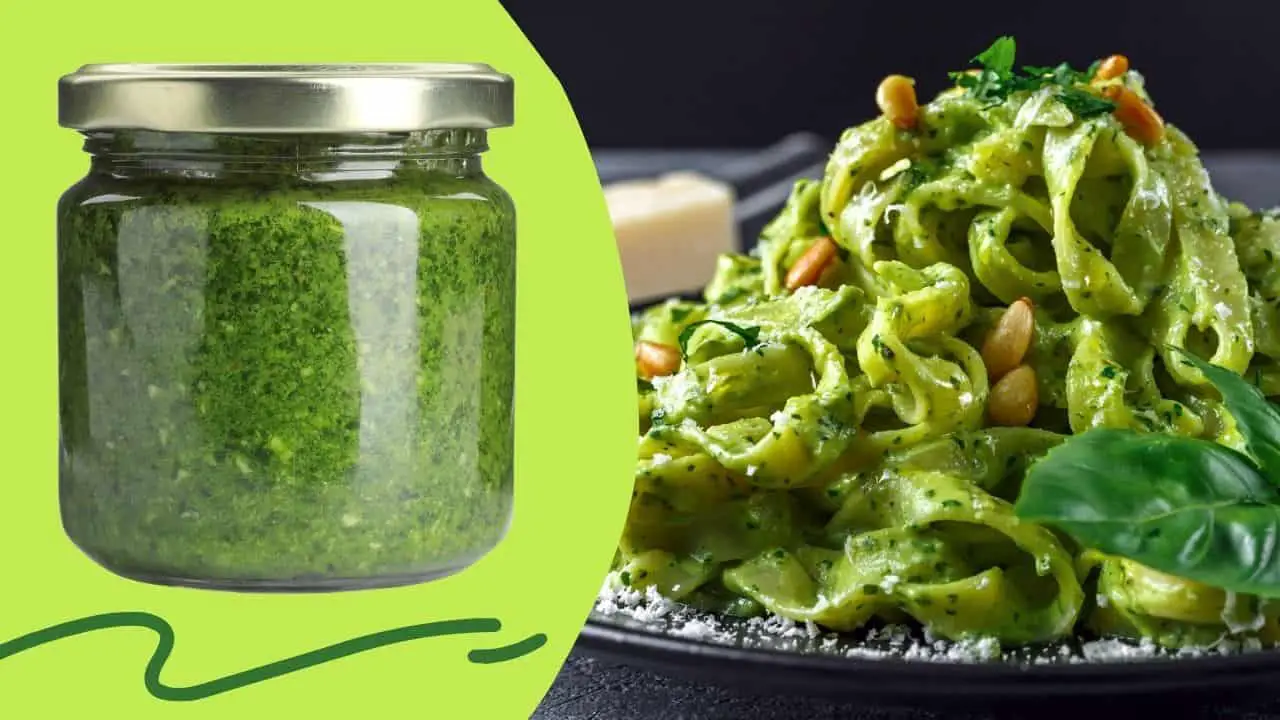Pesto comes in such a little jar but is nutritious and full of rich flavors. It can elevate and liven up your pasta into a delicious and creamy dish.
If you have not used it in your recipes before, then you are in the right place. This post will go over everything you need to know about using pesto from a jar with pasta. It is easier than you think ;).
Why Is Pesto So Good With Pasta?

While pesto is very versatile and can be used in many different recipes, the tastiest and perhaps the most traditional way to use it is to toss it with hot, freshly cooked pasta.
The secret to why pesto and pasta are such a toothsome combination lies behind its ingredients.
Traditional Italian pesto sauce contains the following 6 components:
- Fresh basil
- Olive oil
- Parmesan cheese
- Garlic
- Pine nuts
- Sea salt or kosher salt
However, other vegetables, such as arugula or tomatoes, are used for a different flavor profile than herb-based pesto. In addition, substituting cheese for vegan ingredients such as tofu or cashew nuts can appeal to those on a dairy-free diet.
The ingredients are then added to a food processor until smooth. Initially, pesto was pounded, which translates to ‘pestata’ in Italian, hence the name.
Can You Use Pesto Straight From The Jar?
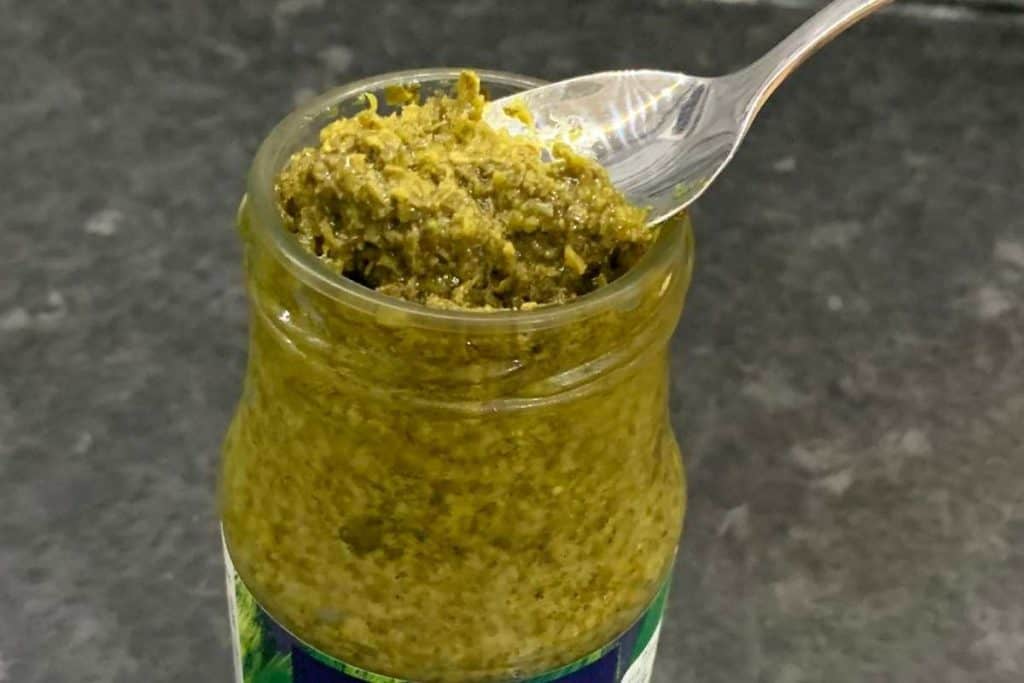
Yes. Pesto is safe to eat straight from the jar. It is recommended not to cook pesto but instead let it absorb heat from the cooked food. You can add it directly to ready-cooked pasta or serve it on bruschetta, in a wrap, or a salad.
How To Use A Jar Of Pesto In Pasta?
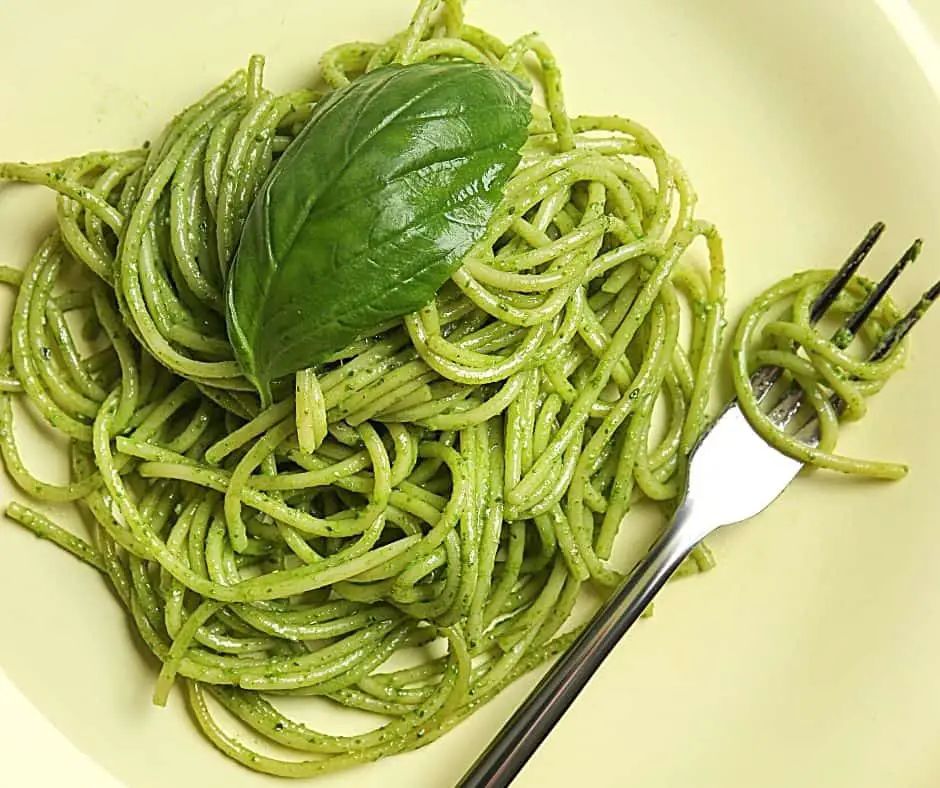
- Boil pasta of your choice till cooked, by following the instructions on the packaging.
- Drain your pasta water and keep it to one side. Leave cooked pasta in the pan or transfer to a large mixing bowl.
- Add pesto from the jar.
- Gently mix the pesto sauce and pasta.
- Optional (recommended): add 2 tbsp of leftover pasta water. This will help the olive oil in the pesto to emulsify and leave you with a creamy sauce.
- Add some toppings (tasty topping ideas below).
- Serve and enjoy.
Read Also: What To Serve With Pesto Pasta? (Try These 7 Delicious Sides).
What Is The Best Pasta For Pesto?
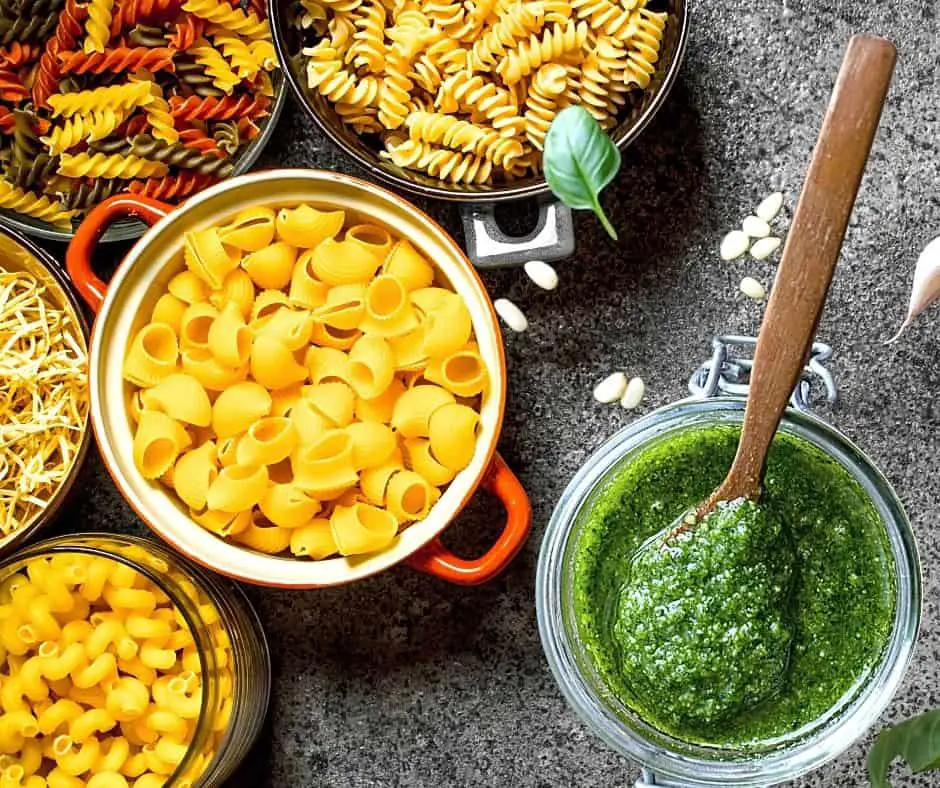
You can use any variety of pasta you choose. Any shape goes! You can use egg-based garganelli, gluten-free fettuccini, dried wheat penne, or my new favorite discovery, chickpea pasta!
Generally, the pasta shapes that work the best are ones with twists and grooves, such as fusilli, or long strand-like pasta, such as spaghetti or linguine, as these grooves and curves hold the sauce making the oils and herbs stick to the pasta.
TOP TIP
You can also cook your pasta Al dente (cooked ‘firm to the bite’) in advance to reheat later. This is great for meal prep. To achieve al dente pasta, follow the cooking instructions on the packaging and remove the pasta from the water when it is slightly chewy on the inside; this is usually about 1-2 minutes from the end of the cooking time.
How Much Pesto For Pasta?

The ratio of pesto to the pasta will depend on your taste preferences. Usually, 2-3 tablespoons of pesto sauce are sufficient for a single serving of pasta of about 75g uncooked weight (175g cooked weight).
You may also wish to thin the pesto sauce with 2-3 tablespoons of starchy pasta water or add a drizzle of olive oil to add moisture and make the pesto go a little further.
Pesto Pasta Toppings:
To take your pasta with shop-bought pesto from the jar to the next level, try adding some of these delicious toppings:
- Fresh basil leaves
- Fresh parsley
- Grated Parmesan cheese
- Pine nuts
- Cherry tomatoes
- Olives
- Arugula
- Fried mushrooms
- Mozarella or burrata cheese
- Black pepper
- Olive oil
- Fried bacon pieces
What Is The Difference Between Red Pesto And Green One?

As mentioned, pesto is traditionally a green sauce with lots of olive oil, basil, and pine nuts, among other ingredients. Red pesto is made using similar ingredients with the addition of sun-dried tomatoes or grilled red bell peppers.
When cooking, you can use red and green pesto interchangeably. The type you choose will depend on your taste.
Some people prefer green pesto for its unique taste compared to most tomato-based Italian sauces. However, some people choose the red one because it is packed with flavor.
Homemade Vs. Store-Bought
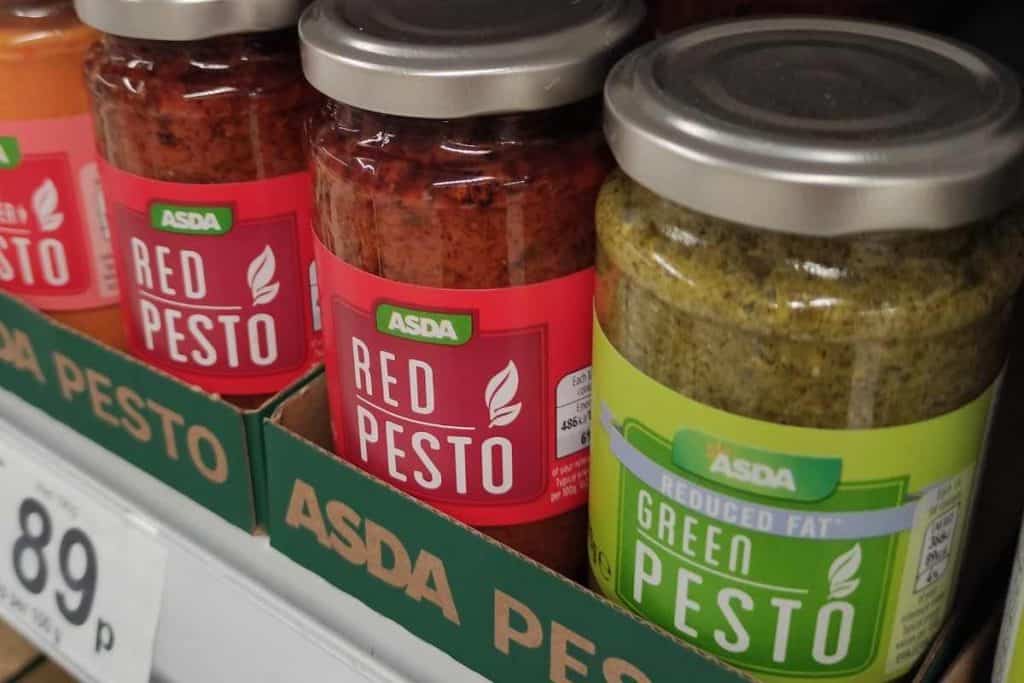
Price-wise, a traditional recipe for homemade pesto and a shop-bought ready-made jar of pesto are similar, once you factor in the expense of the ingredients.
Of course, with homemade recipes, you have the option to choose what goes into your food and the quality of these ingredients. You can also avoid certain preservatives or any ingredients that your body does not agree with.
Also, when purchasing pesto from the supermarket, always check the list of ingredients as some of the store-bought ones are made with sunflower oil instead of olive oil.
However, when it comes to the most convenient option, store-bought pestos like Prego, Barilla, or Filippo Berio wins hands down.
Think of all the washing up you can save by adding a jar of pesto into your shopping cart rather than digging out the chopping board, or food processor, or pounding down all the ingredients with mortar and pestle until they form a fine paste.
Shelf Pesto Vs. Refrigerated
You may have noticed that you can buy pesto from the fridge or the shelf (non-refrigerated) sections of the supermarket.
Typically the refrigerated pesto will be fresher, and this will translate into a better-tasting condiment with fewer preservatives. However, this can come at a slight premium for the price you pay for fresh goods.
The shelf-bought pesto that you can usually find next to jarred pasta sauces is generally cheaper and almost as tasty. Off the shelf, glass jar pesto will last longer once opened and stored in the fridge.
You can use a homemade shelf or refrigerated shop-bought pesto the same as each other. Typically homemade recipes won’t last as long as leftovers, but the cooking process is the same.
How To Make Store-Bought Pesto Better?
Most store-bought pesto is ready to use from the jar and tastes delicious. However, if you want to make it a bit better to impress your guests or infuse a little extra flavor, you can add some of these additional ingredients into the sauce alongside the toppings mentioned above.
- Fresh basil leaves
- Roast garlic bulbs, onions, tomatoes, or bell peppers
- Hard, crumbly cheese such as blue cheese
- Heavy, unsweetened cream
Other Ways To Use Pesto From A Jar
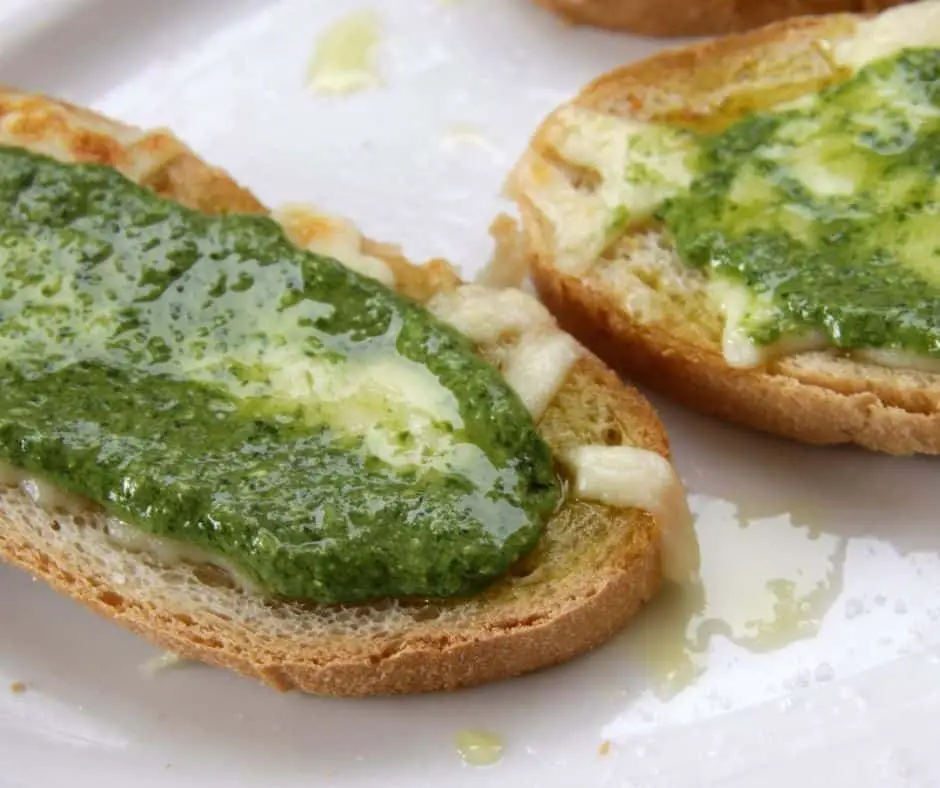
You can use this herby, garlic-y puréed sauce to perk up just about anything.
- Use it on a pizza base. Substitute tomato marinara sauce for green or red pesto and add your toppings as usual.
- Add in salad dressings.
- Toast topper. Add a dollop on top of your egg or mushrooms on toast for a hit of strong flavor.
- Perk up your meat. Pesto packs a punch of flavor so you can add it to beef stew, roast beef, or chicken when the other flavors in the dish are lacking.
FAQs
Can You Reheat Pesto Pasta?
Yes! The best way to reheat pasta is to add it to an oven-safe dish with an extra splash of olive oil and cover it with tin foil (aluminum). Bake in the oven on low to medium heat – approximately 350°F (175°C) – for 15-20 minutes, or until piping hot throughout.
How To Store Leftover Pesto
Always keep the jar of opened leftover pesto in the fridge. Make sure you close the lid tightly and store it for up to 14 days. If you find the pesto is a little dry the next day, you can add a dash of olive oil to rehydrate it.
How To Freeze Pesto In Jar?
You can freeze all the ingredients in a standard jar of pesto. Before freezing, transfer pesto out of the glass jar and into a freezer-safe tub or freezer bag and freeze it for up to 2 months.
If you wish to reuse the pesto in small quantities, freeze it in an ice cube tray. Once the cubes freeze, you can pop them out of the mold and transfer them to a tub or bag.
To use, simply remove from the freezer before eating and leave at room temperature to thaw.
Check out how I made this Protein-Packed Healthy Mac And Cheese – Delicious And Creamy
How Do You Know When Pesto Has Gone Off?
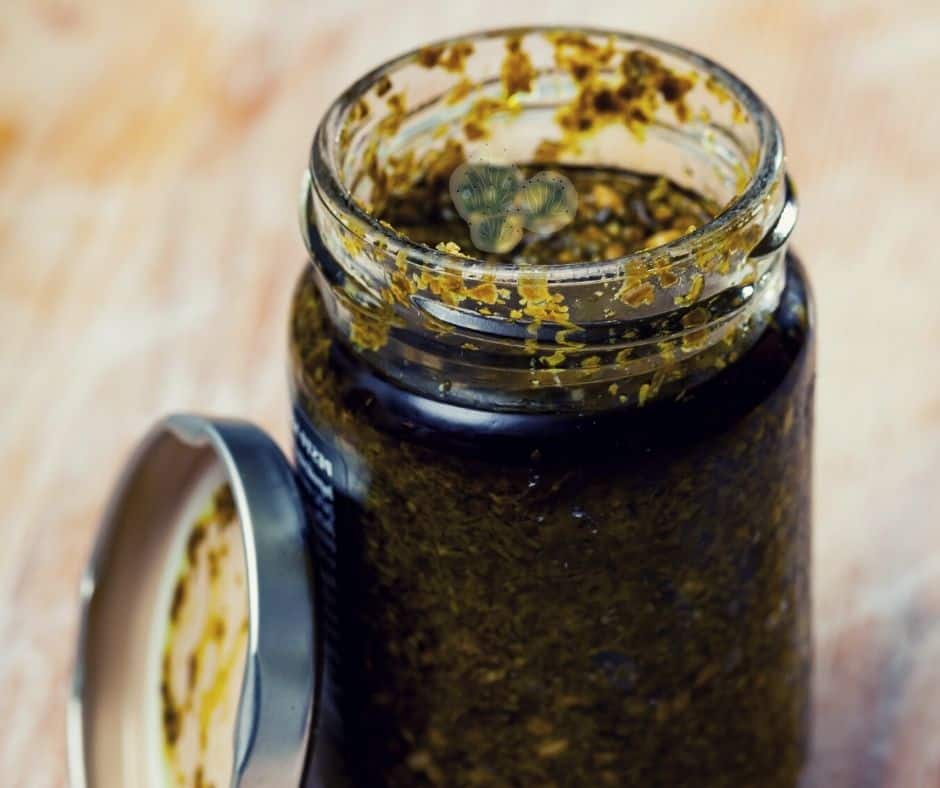
It is pretty easy to identify if pesto has gone bad. Here are a few things to look out for.
Throw it away if you notice any of the following:
- Any organic growth like mold.
- Rotten or rancid smell.
- Color changes from green to brownish.
- Unusual, unpleasant, unsavory taste.
- Or cross-contamination with raw foods.
Read Also: The RAMNUT – Genius Thing You Can Do With Instant Ramen Noodles
